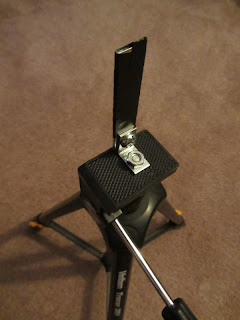The other thing that's always frustrated me about C9 lights are their fragility. It seems like no matter how gently I put up and take down the strings, every year I have to go through the ritual of finding and replacing the burned out bulbs before stringing them on the house. And invariably, the one bulb at the apex of the roof burns out 2 nights after I put it up. And with bulbs going for at least 25¢ apiece, I figure I spend at least $2-$3 a year in bulbs. There's gotta be a better solution...
| Philips C9 faceted Christmas lights |
Enter the LED C9 strings. I bought 4 25-bulb strings of Philips multicolor LED faceted C9 light strings at the local Target to compare to my incandescent C9 strings. Although I had a slight preference for the smooth bulbs, I didn't care for the light dispersal as much - the faceted ones seemed to illuminate the entire "bulb" better.
First test: Energy efficiency
 |
| C9 incandescents - about 160 watts |
Using my trusty Kill-A-Watt energy meter, I plugged in an incandescent C9 string. Just about 160 watts (I had a few flashers in the string, so the wattage varied about 10 watts or so as bulbs flashed on & off). C9s are rated at 7 watts apiece, so a full 25-light string of standard bulbs should be about 175 watts.
 |
| C9 LEDs - just 2(!) watts |
Second test: Aesthetics (how they look)
I know what you're thinking - these things must be ridiculously dim. Truth be told, they are significantly dimmer than C9 incandescents. But the only way to truly judge is on the house, in the dark, side-by-side - so that's exactly what I did. The photo below shows a string of incandescent C9s on the main house (starting to the left of the garage door) and a string of LED C9s on the right (over the garage door). The difference is obvious - you could probably read a book by the incandescents, while the LEDs serve to add just a hint of color to the roofline.
 |
| Incandescent C9s on the left, LED C9s on the right (click for an enlarged image) |
As much of a traditionalist as I am, I was surprised to find that I actually prefer the LED lights. They don't light up the walls of the house, so they don't get washed out by their own brightness. Couple that with the energy efficiency and lack of annual maintenance, and we have a winner, at least in my book.
Third test: economics (are they worth it?)
So - aesthetics aside, is it worth it economically to use LED C9s instead of incandescents?
If you're buying new, I think that LEDs are a no-brainer unless you really have an issue with their brightness. They cost about double upfront ($12 vs $6 per 25-light string), but factor in the need to replace bulbs and the electricity difference and the payback is probably 1-3 years.
In my case, I was trying to determine the payback period considering that I already had the incandescent strings. Here's my thought process and calculations - you'll have to do the math for your scenario and see what works.
I have 4 strings of incandescents. 4 strings of LEDs runs $48.00 + tax - lets round to $50 (I bought mine on sale for $11 each). I typically have my lights on between Thanksgiving and Christmas, about 4 hours each night. My wintertime electricity rate is about 12¢ per kWh, so let's run the numbers:
Cost per year for incandescents:
- Replacement bulbs: $2.00
- Electricity: 160 watts / string x 4 strings x 4 hours / night x 30 nights / year = 76,800 watts (or 76.8 kWh) x 12¢ / kWh = $9.21
So I'm paying about $11.21 per year for my current display.
Cost per year for LEDs:
- Replacement bulbs: $0.00 (each sting included 2 replacement LEDs, but I can't imagine them going bad more than 1-2 per decade - time will tell).
- Electricity: 2 watts / string x 4 strings x 4 hours / night x 30 nights / year = 960 watts (or 0.96 kWh) x 12¢ / kWh = $0.11
So I'll be paying 11¢ per year for the LEDs.
And the Winner is: LEDs
Factor in the upfront cost of $50.00 for the LED strings and you'll see that the breakeven point is between 4 and 5 years for my scenario. Yours might be different, but I think that in most cases, there's still an excellent case to be made for LED outdoor Christmas lights.
Merry Christmas to you and yours!
Update 11/23/12: X-10 modules and LED lights don't mix (well)
 |
| X-10 modules |
Using the oracle of Google, one can find a number of solutions to this issue - most involving putting a small load on the switched side of the X10 module with the LED lighting - something like an incandescent night light, a plug-in air freshener or even a "wall wart" transformer. There are also mentions of more sophisticated solutions involving opening up the X10 module and adding or removing resistors.
I opted for the low-tech approach of plugging in a wall wart on the switched side of my X10 modules. Even without being plugged into anything the wall wart transformer draws enough energy to keep the LED string dark. It's kludgy, but it works.















